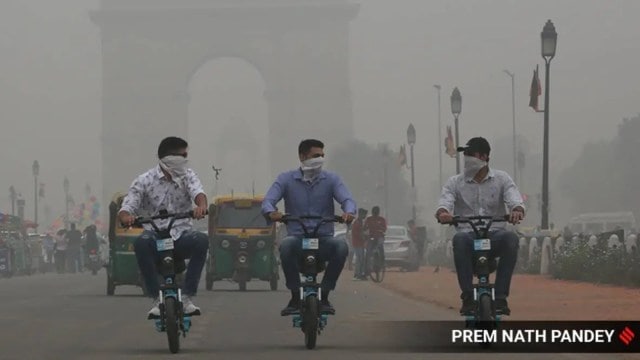
The delayed onset of the La Niña and the late retreat of the monsoon have eroded the optimism that Delhi’s residents could experience better air this winter compared to previous years. It now seems that a large part of north India will face significant pollution-related challenges in the early winter months, with the possibility of some relief in December and January depending on how quickly La Niña conditions strengthen. If stubble burning occurs even at half the intensity of the past few years, the situation could worsen in November.
Recent research by scientists at the National Institute of Advanced Science (NIAS) has underlined the links between climate change, La Niña and air quality. It described the impact of these three factors on air quality in India during the winter of 2022-23, when Delhi experienced its best air in a decade. The predictions by meteorologists around the globe of the onset of La Niña before the onset of monsoon over large parts of India had offered great relief. The phenomenon is typically linked to stronger monsoons in India. Despite its late onset, the country has experienced good rainfall. However, the uncertainty over the arrival of La Niña has added to the precarity of the winter air.
Gone are the days when air pollution used to be only “local emission-centric” and a region-specific problem. In an era of rapidly changing climate, researchers need to shift from an emission-centric approach to one that focuses on larger meteorological and climatological processes and maps airsheds. This is especially so in the context of Delhi’s air quality, where winter months exacerbate the already grim situation. The influence of large-scale atmospheric circulations such as ENSO, changes in wind patterns and the behaviour of pollutants over long distances require greater attention. This dynamic introduces complexities in how emissions from neighbouring regions, even different countries, contribute to local air quality. Policymakers should not lose sight of the challenges posed by PM2.5. Mitigating its emissions means framing policies related to its dominant sources, fossil fuels with a toxic chemical content. However, there seems to be an overemphasis on PM10 and its dominant source, dust. In the past, this has led to a misallocation of resources, wrong focus and priorities and undermining of public health concerns.
The air quality outlook for the winter in the entire country, based on an analysis of climatic processes using the NIAS-SAFAR model, paints a concerning picture for Delhi. This is especially so given the delay in the monsoon’s retreat, a severe winter and the La Niña still playing hide and seek. Let’s demystify these factors and delineate their likely role in shaping air quality in the coming winter. For one, the slower withdrawal of the monsoon typically leads to extended periods of high humidity and calm winds. This, combined with the anti-cyclonic circulation in the post-monsoon period, results in reduced atmospheric mixing and dispersion of pollutants. This will likely result in elevated levels of PM2.5 and PM10 in the pre-winter period, with local emissions and pollutants from surrounding areas remaining trapped near the surface.
Two, the delayed onset of La Niña is a matter of concern. La Niña brings stronger winds and more dynamic atmospheric circulation, which helps disperse pollutants in northern India. However, the earliest that La Niña is expected to develop is between September and November 2024. The neutral conditions will, therefore, contribute to stagnant surface winds, exacerbating the pollution problem in northern India in autumn and early winter.
Let’s now bring stubble burning into the equation. Given the dominance of north-north-westerly winds at 850-900 mb, in the absence of La Niña conditions, stubble burning in Punjab and Haryana is likely to have a significant impact in undermining Delhi’s air quality.
What if the onset of La Niña is in December and January? In other words, what if the World Meteorological Organisation’s prediction of a 55 per cent chance for La Niña by December holds good? In that case, the NIAS-SAFAR model suggests that stronger winds, feeble westerly disturbances and fewer clouds may reduce the accumulation of pollutants and improve the air quality slightly in the later part of winter. However, La Nina could also bring a longer and more severe winter. This will contribute to the lowering of the inversion layer — the part of the atmosphere that traps pollutants — and limit vertical mixing. This could restrict the benefit from the stronger winds. In other words, though air quality might improve relative to early winter the situation will remain problematic in Delhi and parts of north India.
The NIAS-SAFAR model also suggests that had La Niña settled in by July, as initially predicted, it could have worsened the winter air of the country’s peninsular region by at least 20 per cent, especially concerning PM 2.5 pollution. At the same time, an early onset of La Niña could have led to improvements in the northern zone.
There is growing evidence to support the belief that the unusual occurrences in extreme air pollution are linked to climate change. In a warming world, other than local anthropogenic emissions, rapidly changing climate is an additional uncertainty that requires more rigorous mitigation efforts. There is a need to focus on larger airsheds rather than concentrating on individual cities. It’s time to rethink air quality strategies by scientifically integrating broader factors and prioritising health-centric measures which can best be realised by a resource framework as envisaged by scientific bodies in collaboration with the office of the Principal Scientific Advisor.
The writer is chair professor, NIAS, IISc-Campus, Bengaluru and founder, SAFAR



